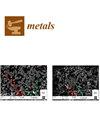Simulation of Localized Stress Impact on Solidification Pattern during Plasma Cladding of WC Particles in Nickel-Based Alloys by Phase-Field Method
IF 2.5
3区 材料科学
Q3 MATERIALS SCIENCE, MULTIDISCIPLINARY
引用次数: 0
Abstract
As materials science continues to advance, the correlation between microstructure and macroscopic properties has garnered growing interest for optimizing and predicting material performance under various operating conditions. The phase-field method has emerged as a crucial tool for investigating the interplay between microstructural characteristics and internal material properties. In this study, we propose a phase-field approach to couple two-phase growth with stress–strain elastic energy at the mesoscale, enabling the simulation of local stress effects on the solidified structure during the plasma cladding of WC particles and nickel-based alloys. This model offers a more precise prediction of microstructural evolution influenced by stress. Initially, the phase field of WC-Ni binary alloys was modeled, followed by simulations of actual local stress conditions and their impacts on WC particles and nickel-based alloys with ProCAST and finite element analysis software. The results indicate that increased stress reduces grain boundary migration, decelerates WC particle dissolution and diffusion, and diminishes the formation of reaction layers and Ostwald ripening. Furthermore, experimental validation corroborated that the model’s predictions were consistent with the observed microstructural evolution of WC particles and nickel-based alloy composites.用相场法模拟镍基合金中 WC 粒子等离子熔覆过程中局部应力对凝固模式的影响
随着材料科学的不断进步,微观结构与宏观性能之间的相关性在优化和预测各种工作条件下的材料性能方面引起了越来越多的关注。相场方法已成为研究微观结构特征与材料内部性能之间相互作用的重要工具。在本研究中,我们提出了一种相场方法,在中观尺度上将两相生长与应力-应变弹性能结合起来,从而能够模拟 WC 粒子和镍基合金等离子熔覆过程中凝固结构的局部应力效应。该模型可以更精确地预测受应力影响的微观结构演变。首先对 WC-Ni 二元合金的相场进行建模,然后使用 ProCAST 和有限元分析软件模拟实际局部应力条件及其对 WC 颗粒和镍基合金的影响。结果表明,应力的增加会减少晶界迁移,减缓 WC 颗粒的溶解和扩散,减少反应层的形成和奥斯特瓦尔德熟化。此外,实验验证证实了该模型的预测与观察到的 WC 颗粒和镍基合金复合材料的微观结构演变一致。
本文章由计算机程序翻译,如有差异,请以英文原文为准。
求助全文
约1分钟内获得全文
求助全文
来源期刊

Metals
MATERIALS SCIENCE, MULTIDISCIPLINARY-METALLURGY & METALLURGICAL ENGINEERING
CiteScore
4.90
自引率
13.80%
发文量
1832
审稿时长
1.5 months
期刊介绍:
Metals (ISSN 2075-4701) is an open access journal of related scientific research and technology development. It publishes reviews, regular research papers (articles) and short communications. Our aim is to encourage scientists to publish their experimental and theoretical results in as much detail as possible. Therefore, there is no restriction on the length of the papers. The full experimental details must be provided so that the results can be reproduced. Metals provides a forum for publishing papers which advance the in-depth understanding of the relationship between the structure, the properties or the functions of all kinds of metals.
 求助内容:
求助内容: 应助结果提醒方式:
应助结果提醒方式:


